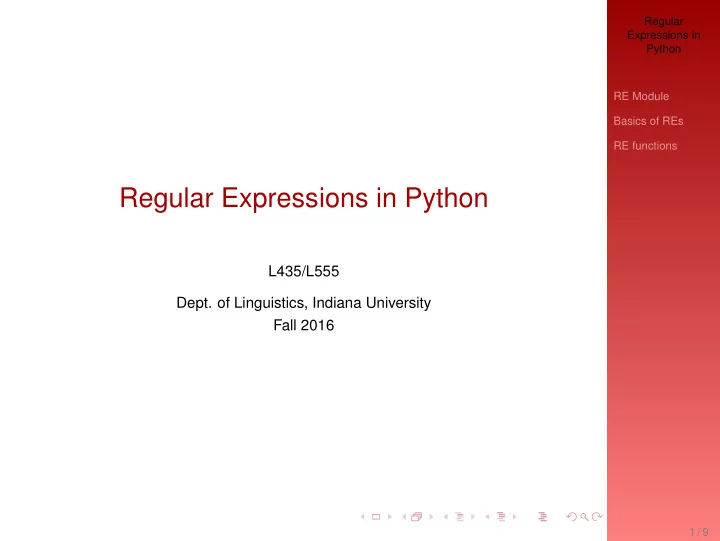

Regular Expressions in Python RE Module Basics of REs RE functions Regular Expressions in Python L435/L555 Dept. of Linguistics, Indiana University Fall 2016 1 / 9
Regular expression module Regular Expressions in Python RE Module Basics of REs RE functions Module In order to use regular expressions, we need to load the module. import re 2 / 9
Regular expression symbols Regular Expressions in Python RE Module Basics of REs . wildcard RE functions \ escapes specials characters [ . . . ] character set [ ∧ . . . ] complement of character set | or * Kleene star: 0 or more (of previous) + Kleene plus: 1 or more (of previous) { m,n } repeat between m and n times ∧ beginning of a string $ end of a string 3 / 9
Understanding regular expressions Regular Expressions in Python RE Module Basics of REs RE functions See slides 28–37 here: http: //cl.indiana.edu/ ∼ md7/16/245/slides/04-searching/slides.pdf 4 / 9
Regular expression functions Regular Expressions in Python RE Module Basics of REs RE functions compile( < pattern > ) compiles a regex pattern into a pattern object – for reuse search( < pattern > , < string > ) searches for regex pattern in string match( < pattern > , < string > ) checks at beginning of string split( < pattern > , < string > ) splits the string based on pat- tern, returns a list findall( < pattern > , < string > ) returns a list of all occurrences sub( < pat > , < rep > , < string > ) replaces pat by rep in string 5 / 9
Example Regular Expressions in Python RE Module Basics of REs RE functions import re mysent = input ( ’ Give me a sentence ! \ n ’ ) ( not re . search ( ’ [ ! \ . ; ? ] ’ , mysent ) ) : i f print ( ’ t h i s i s not a sentence ’ ) 6 / 9
Example Regular Expressions in Python RE Module Basics of REs RE functions import re mysent = input ( ’ Give me a sentence ! \ n ’ ) newstr = re . sub ( ’ [A − Z ] ’ , ’XX ’ , mysent ) print ( newstr ) 7 / 9
Pattern objects Regular Expressions in Python Module RE Module Basics of REs The functions compile, search, and match return a RE functions pattern object. The objects contain information about the pattern itself and for the matching functions also information about the matched segments in the string. import re phoneNums = re . compile ( ’ ˆ \ (? \ d { 3 } [ − ) ] \ d { 3 } [ − ] \ d { 4 } $ ’ ) myphone = input ( ’ Give me a phone number : ’ ) i f phoneNums . search (myphone ) : print ( ’ format correct ’ ) else : print ( ’ format i n c o r r e c t ’ ) 8 / 9
Example Regular Expressions in Python RE Module Basics of REs RE functions import re mysent = ’ a rose i s a rose i s a rose ’ a l l s t r = re . search ( ’ ( . ) ’ , mysent ) print ( a l l s t r . group ( 1 ) ) a l l s t r = re . f i n d a l l ( ’ ( . ) ’ , mysent ) print ( a l l s t r ) 9 / 9
Recommend
More recommend